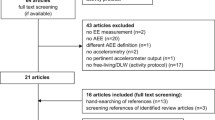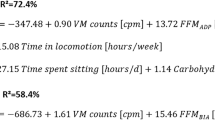Abstract
This study evaluated the validity of the total energy expenditure (TEE) estimated using uniaxial (ACCuni) and triaxial (ACCtri) accelerometers in the elderly. Thirty-two healthy elderly (64–87 years) participated in this study. TEE was measured using the doubly labeled water (DLW) method (TEEDLW). TEEACCuni (6.79 ± 1.08 MJ day−1) was significantly lower than TEEDLW (7.85 ± 1.54 MJ day−1) and showed wider limits of agreement (−3.15 to 1.12 MJ day−1) with a smaller correlation coefficient (r = 0.703). TEEACCtri (7.88 ± 1.27 MJ day−1) did not differ from TEEDLW and showed narrower limits of agreement (−1.64 to 1.72 MJ day−1) with a larger correlation coefficient (r = 0.835, P < 0.001). The estimated intensities of light activities were significantly lower with ACCuni. Greater mediolateral acceleration was observed during 6-min walk tests. The results suggest that ACCtri is a better choice than ACCuni for assessing TEE in the elderly.




Similar content being viewed by others
References
Black AE, Prentice AM, Coward WA (1986) Use of food quotients to predict respiratory quotients for the doubly-labelled water method of measuring energy expenditure. Hum Nutr Clin Nutr 40:381–391
Blanc S, Colligan AS, Trabulsi J et al (2002) Influence of delayed isotopic equilibration in urine on the accuracy of the H-2(2) O-18 method in the elderly. J Appl Physiol 92:1036–1044
Blanc S, Schoeller DA, Bauer D et al (2004) Energy requirements in the eighth decade of life. Am J Clin Nutr 79:303–310
Bland JM, Altman DG (1995) Comparing methods of measurement—why plotting difference against standard method is misleading. Lancet 346:1085–1087. doi:10.1016/S0140-6736(95)91748-9
Bonnefoy M, Normand S, Pachiaudi C et al (2001) Simultaneous validation of ten physical activity questionnaires in older men: a doubly labeled water study. J Am Geriatr Soc 49:28–35. doi:10.1046/j.1532-5415.2001.49006.x
Bouten CV, Westerterp KR, Verduin M et al (1994) Assessment of energy-expenditure for physical-activity using a triaxial accelerometer. Med Sci Sports Exerc 26:1516–1523. doi:10.1249/00005768-199412000-00016
Bouten CVC, VerboeketVandeVenne W, Westerterp KR et al (1996) Daily physical activity assessment: comparison between movement registration and doubly labeled water. J Appl Physiol 81:1019–1026
Brage S, Ekelund U, Brage N et al (2007) Hierarchy of individual calibration levels for heart rate and accelerometry to measure physical activity. J Appl Physiol 103:682–692. doi:10.1152/japplphysiol.00092.2006
Chen KY, Sun M (1997) Improving energy expenditure estimation by using a triaxial accelerometer. J Appl Physiol 83:2112–2122
Coward WA (1990) Calculation of pool sizes and flux rates. In: Prentice AM (ed) The doubly-labelled water method for the measurement of energy expenditure. International Atomic Energy Agency, Vienna, pp 48–65
Crouter SE, Churilla JR, Bassett DR Jr (2006a) Estimating energy expenditure using accelerometers. Eur J Appl Physiol 98:601–612. doi:10.1007/s00421-006-0307-5
Crouter SE, Clowers KG, Bassett DR Jr (2006b) A novel method for using accelerometer data to predict energy expenditure. J Appl Physiol 100:1324–1331. doi:10.1152/japplphysiol.00818.2005
Davis MG, Fox KR (2007) Physical activity patterns assessed by accelerometry in older people. Eur J Appl Physiol 100:581–589. doi:10.1007/s00421-006-0320-8
Dean JC, Alexander NB, Kuo AD (2007) The effect of lateral stabilization on walking in young and old adults. IEEE Trans Biomed Eng (in press)
Donelan JM, Shipman DW, Kram R et al (2004) Mechanical and metabolic requirements for active lateral stabilization in human walking. J Biomech 37:827–835. doi:10.1016/j.jbiomech.2003.06.002
Ekelund U, Aman J, Westerterp K (2003) Is the ArteACC index a valid indicator of free-living physical activity in adolescents? Obes Res 11:793–801. doi:10.1038/oby.2003.110
Eston RG, Rowlands AV, Ingledew DK (1998) Validity of heart rate, pedometry, and accelerometry for predicting the energy cost of children’s activities. J Appl Physiol 84:362–371
Fox KR, Stathi A, McKenna J et al (2007) Physical activity and mental well-being in older people participating in the better ageing project. Eur J Appl Physiol 100:591–602. doi:10.1007/s00421-007-0392-0
Hara T, Matsumura Y, Yamamoto M et al (2006) The relationship between body weight reduction and intensity of daily physical activities assessed with 3-dimension accelerometer. Jpn J Phys Fit Sports Med 55:385–391
Harris AM, Lanningham-Foster LM, McCrady SK et al (2007) Nonexercise movement in elderly compared with young people. Am J Physiol Endocrinol Metab 292:E1207–E1212. doi:10.1152/ajpendo.00509.2006
Health Promotion and Nutrition Division-Health Service Bureau Ministry of Health and Welfare (1995) Recommended dietary allowances for the Japanese, 4th revision, Dai-ichi Shuppan, Tokyo
Ishiguro N, Kanehisa H, Miyatani M et al (2006) Applicability of segmental bioelectrical impedance analysis for predicting trunk skeletal muscle volume. J Appl Physiol 100:572–578. doi:10.1152/japplphysiol.00094.2005
Ishikawa-Takata K, Tabata I, Sasaki S et al (2007) Physical activity level in healthy free-living Japanese estimated by doubly labelled water method and International Physical Activity Questionnaire. Eur J Clin Nutr. Epub ahead of print. doi:10.1038/sj.ejcn.1602805
Iwashita S, Takeno Y, Okazaki K et al (2003) Triaxial accelerometry to evaluate walking efficiency in older subjects. Med Sci Sports Exerc 35:1766–1772. doi:10.1249/01.MSS.0000089350.54959.CB
Judge JO, Ounpuu S, Davis RB (1996) Effects of age on the biomechanics and physiology of gait. Clin Geriatr Med 12:659–671
Koebnick C, Wagner K, Thielecke F et al (2005) Validation of a simplified physical activity record by doubly labeled water technique. Int J Obes 29:302–309. doi:10.1038/sj.ijo.0802882
Kumahara H, Schutz Y, Ayabe M et al (2004a) The use of uniaxial accelerometry for the assessment of physical-activity-related energy expenditure: a validation study against whole-body indirect calorimetry. Br J Nutr 91:235–243. doi:10.1079/BJN20031033
Kumahara H, Tanaka H, Terrier P et al (2004b) Comparison of 2 accelerometers for assessing daily energy expenditure in adults. J Phys Act Health 1:270–280
Mahabir S, Baer DJ, Giffen C et al (2006) Comparison of energy expenditure estimates from 4 physical activity questionnaires with doubly labeled water estimates in postmenopausal women. Am J Clin Nutr 84:230–236
Manini TM, Everhart JE, Patel KV et al (2006) Daily activity energy expenditure and mortality among older adults. JAMA 296:171–179. doi:10.1001/jama.296.2.171
Matsumura Y, Yamamoto M, Kitado T et al (2008) High-accuracy physical activity monitor utilizing three-axis accelerometer. Natl Tech Rep 56:60–66
Meijer EP, Goris AHC, Wouters L et al (2001) Physical inactivity as a determinant of the physical activity level in the elderly. Int J Obes 25:935–939. doi:10.1038/sj.ijo.0801644
Meng XL, Rosenthal R, Rubin DB (1992) Comparing correlated correlation-coefficients. Psychol Bull 111:172–175. doi:10.1037/0033-2909.111.1.172
Meydani M (2001) Nutrition interventions in aging and age-associated disease. In: Healthy aging for functional longevity, pp 226–235
Mian OS, Thom JM, Ardigo LP et al (2006) Metabolic cost, mechanical work, and efficiency during walking in young and older men. Acta Physiol (Oxf) 186:127–139. doi:10.1111/j.1748-1716.2006.01522.x
Miyatani M, Kanehisa H, Masuo Y et al (2001) Validity of estimating limb muscle volume by bioelectrical impedance. J Appl Physiol 91:386–394
Morio B, Ritz P, Verdier E et al (1997) Critical evaluation of the factorial and heart-rate recording methods for the determination of energy expenditure of free-living elderly people. Br J Nutr 78:709–722. doi:10.1079/BJN19970189
Murray MP, Kory RC, Clarkson BH (1969) Walking patterns in healthy old men. J Gerontol 24:169–178
Nichols JF, Patterson P, Early T (1992) A validation of a physical-activity monitor for young and older adults. Can J Sport Sci 17:299–303
Ortega JD, Farley CT (2007) Individual limb work does not explain the greater metabolic cost of walking in elderly adults. J Appl Physiol 102:2266–2273. doi:10.1152/japplphysiol.00583.2006
Plasqui G, Westerterp KR (2007) Physical activity assessment with accelerometers: an evaluation against doubly labeled water. Obesity (Silver Spring) 15:2371–2379. doi:10.1038/oby.2007.281
Plasqui G, Joosen A, Kester AD et al (2005) Measuring free-living energy expenditure and physical activity with triaxial accelerometry. Obes Res 13:1363–1369. doi:10.1038/oby.2005.165
Racette SB, Schoeller DA, Luke AH et al (1994) Relative dilution spaces of 2H- and 18O-labeled water in humans. Am J Physiol Endocrinol Metab 267:E585–E590
Rafamantanantsoa HH, Ebine N, Yoshioka M et al (2002) Validation of three alternative methods to measure total energy expenditure against the doubly labeled water method for older Japanese men. J Nutr Sci Vitaminol (Tokyo) 48:517–523
Rothenberg E, Bosaeus I, Lernfelt B et al (1998) Energy intake and expenditure: validation of a diet history by heart rate monitoring, activity diary and doubly labeled water. Eur J Clin Nutr 52:832–838. doi:10.1038/sj.ejcn.1600655
Rothney MP, Neumann M, Beziat A et al (2007) An artificial neural network model of energy expenditure using nonintegrated acceleration signals. J Appl Physiol 103:1419–1427. doi:10.1152/japplphysiol.00429.2007
Saito N, Yamamoto T, Sugiura Y et al (2004) Lifecorder: a new device for the long-term monitoring of motor activities for Parkinson’s disease. Intern Med 43:685–692. doi:10.2169/internalmedicine.43.685
Schoeller DA, Ravussin E, Schutz Y et al (1986) Energy expenditure by doubly labeled water: validation in humans and proposed calculation. Am J Physiol Regul Integr Comp Physiol 250:R823–R830
Seale JL, Klein G, Friedmann J et al (2002) Energy expenditure measured by doubly labeled water, activity recall, and diet records in the rural elderly. Nutrition 18:568–573. doi:10.1016/S0899-9007(02)00804-3
St-Onge M, Mignault D, Allison DB et al (2007) Evaluation of a portable device to measure daily energy expenditure in free-living adults. Am J Clin Nutr 85:742–749
Starling RD, Matthews DE, Ades PA et al (1999) Assessment of physical activity in older individuals: a doubly labeled water study. J Appl Physiol 86:2090–2096
Tanaka C, Tanaka S, Kawahara J et al (2007a) Triaxial accelerometry for assessment of physical activity in young children. Obesity (Silver Spring) 15:1233–1241. doi:10.1038/oby.2007.145
Tanaka NI, Miyatani M, Masuo Y et al (2007b) Applicability of a segmental bioelectrical impedance analysis for predicting the whole body skeletal muscle volume. J Appl Physiol 103:1688–1695
Touno M, Hasina RH, Ebine N et al (2003) Measurement of total energy expenditure in Japanese firefighters under normal working condition using the doubly labeled water method. Jpn J Phys Fit Sports Med 52:265–274
Trost SG, Way R, Okely AD (2006) Predictive validity of three ActiGraph energy expenditure equations for children. Med Sci Sports Exerc 38:380–387. doi:10.1249/01.mss.0000183848.25845.e0
Turley KR, McBride PJ, Wilmore JH (1993) Resting metabolic rate measured after subjects spent the night at home vs at a clinic. Am J Clin Nutr 58:141–144
United Nations Department of Economic and Social Affairs-Population Division (2007) World population ageing 2007. United Nations publication, New York
Weir JB (1949) New methods for calculating metabolic rate with special reference to protein metabolism. J Physiol 109:1–9
Westerterp KR (1999) Physical activity assessment with accelerometers. Int J Obes 23:S45–S49. doi:10.1038/sj.ijo.0800883
Wong TC, Webster JG, Montoye HJ et al (1981) Portable accelerometer device for measuring human energy-expenditure. IEEE Trans Biomed Eng 28:467–471. doi:10.1109/TBME.1981.324820
Acknowledgments
The authors thank Prof. Dale A. Schoeller (Nutritional Sciences, University of Wisconsin, Madison) for helpful discussions and editing the entire manuscript. The authors also thank the individuals who participated in this study. This study was supported by a research grant to MK from the Ministry of Education, Culture, Sports, Science and Technology, Japan (18300218) and a research grant to YY as part of a research fellowship of the Japan Society for the Promotion of Science for Young Scientists (19-1440).
Author information
Authors and Affiliations
Corresponding author
Additional information
An erratum to this article can be found online at http://dx.doi.org/10.1007/s00421-016-3376-0.
Rights and permissions
About this article
Cite this article
Yamada, Y., Yokoyama, K., Noriyasu, R. et al. Light-intensity activities are important for estimating physical activity energy expenditure using uniaxial and triaxial accelerometers. Eur J Appl Physiol 105, 141–152 (2009). https://doi.org/10.1007/s00421-008-0883-7
Accepted:
Published:
Issue Date:
DOI: https://doi.org/10.1007/s00421-008-0883-7




